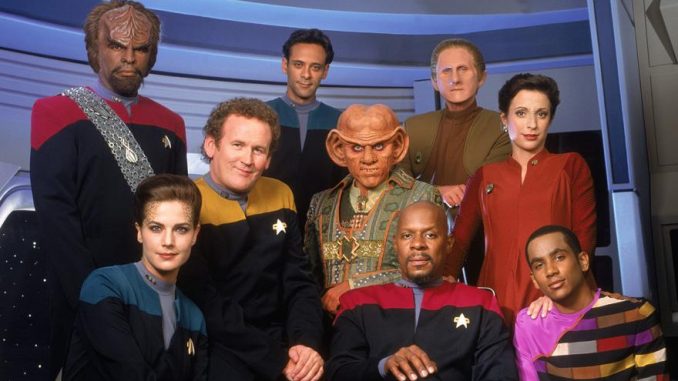
Strap in dear readers, and brace yourselves for the nerdiest but most passionate article you’ll ever see in this current incarnation of The New Paltz Oracle. “Star Trek: Deep Space 9 (DS9)” is my favorite Trek, and I think it’s the best one too.
All right, before going in deeper, I have a few caveats. I’ve seen nearly every episode of “The Original Series (TOS)” and “The Next Generation (TNG),” but haven’t delved too deeply into “Voyager” outside of a few one-off episodes. I haven’t seen “Enterprise” yet, but cut me some slack — nearly every version of Trek is over 100 episodes long, with some falling just under 200. Marathoning all the series is gonna take time, and I only have so much of that on this mortal plane.
I also haven’t been keeping up with NuTrek, such as “Star Trek: Picard (STP)” and “Star Trek: Discovery (STD … err, I mean DIS).” But then again, with infamous Hollywood hack Alex Kurtzman at the helm of these series, why should I? That man wrote, directed and produced 2017’s “The Mummy.” That man has screenwriting disaster written all over him, and the more I read up on his incarnations of Trek, the more baffled I get.
So anyway, back to “DS9.” “DS9” shook up the conventional Star Trek formula in a radical way. Previous Treks featured a brave captain helming a starship to seek out new life, to boldly go where no man has gone before, and deal with the alien or anomaly of the week. Here, however, most of the series takes place in one location, the space station Deep Space 9.
Okay, so what? They changed location and they’re not going anywhere? Why should that matter?
I’ll tell you why it matters: by situating the series in one spot (for the most part) you completely alter the DNA of the story. It goes from a sci-fi adventure of the week with some continuity to a cohesive multi-part narrative that places a great emphasis on continuity and overarching narratives. One of the best aspects of “DS9” is the fact that nearly every episode serves as a small piece of the larger narrative.
Ah, and that larger narrative. “DS9” features one of the best narratives in serialized television and the Star Trek franchise. The plot is centered on the human and alien crew of the titular space station. After being taken over by Starfleet, the de facto good guys of the franchise, a wormhole opens up that leads to a whole different part of the galaxy. Whoever has control of the wormhole has control of the galaxy at large, and there’s a hierarchical, tyrannical empire on the other end of it.
“DS9” stands in stark contrast to the previous series’ (“The Original Series” and “The Next Generation”) lighter tones, but still retains their overall optimism. Star Trek presents a peaceful, post-scarcity future through the United Federation of Planets, but “DS9” makes it clear that this future is fought for with blood, sweat and tears.
The casting and characters of the series are a cut above the rest. The lead Starfleet commander (and later captain!) of this series is Benjamin Sisko, played by the brilliant Avery Brooks. Sisko is the most interesting Trek lead to date, being by far the most human of any of the other leads. Captain Kirk (William Shatner) is the brave and fearless explorer, Jean-Luc Picard (Sir Patrick Stewart) is the intellectual French gentleman, but Sisko is different.
The man’s a widower, left to take care of his only son, and he’s assigned to this station in an intergalactic equivalent of the boonies. But Sisko is given a lot of character. He’s bold, he’s cunning; he has an interest in civil rights issues of the past and a love for baseball. The man’s declared as the savior of an entire alien species, and his journey is about a man broken by loss and war putting the pieces together and rising to the status of godhood. Brooks radiates passion in every scene he’s in, whether he’s speaking, shouting, crying or whispering.
The series also features TNG veterans, Klingon Lt. Commander Worf (Michael Dorn) and human Chief Engineer Miles O’Brien (Colm Meaney) in an expanded role. Worf was consistently jobbed in TNG by stronger aliens of the week and O’Brien was just a redshirt with a name. Here, Worf is finally given the respect and characterization he deserves by being a badass warrior standing up for his beliefs, while O’Brien proves to be the best-damned engineer in Starfleet and a tough-as-nails veteran.
Above all else, the series moves away from its human-centric roots and examines the values of truly alien cultures. The Ferengi, a species made to parody our own, are shallow, misogynistic and obsessed with money. However, the Ferengi characters are some of the most clever on the show, being able to see clearly through the schemes of all the other characters and run on the cold, calculated logic of profit and loss. The Cardassians are cut-throat espionage experts and tyrants who ran an alien planet roughshod for half a century, but they are masters of their craft and make some of the toughest and necessary choices on the entire show.
So with that, “DS9” is by far my favorite Star Trek series. It builds off the previous two series in a bold way, has a cast of fully fleshed-out characters, an engaging long-form story before that was even popular and shines a light on the alien cultures that had made the series so well known. A sci-fi soap opera with some shlock and aliens with rubber foreheads? Perhaps. But it’s a series that I’ll love for a very long time.
